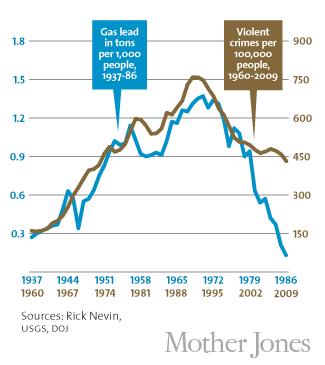 The Brennan Center has released a lengthy report examining the reasons for the big crime decline of the 90s and aughts, and one section highlights the work of Jessica Reyes and others linking crime levels to gasoline lead emissions:
The Brennan Center has released a lengthy report examining the reasons for the big crime decline of the 90s and aughts, and one section highlights the work of Jessica Reyes and others linking crime levels to gasoline lead emissions:
Reyes, and other researchers, have found that lead is connected to aggressive behavior and behavioral problems because it affects brain development of children….Reyes found that the decrease in lead caused a remarkable 56 percent of the decrease in violent crime in the 1990s….This theory had been previously suggested by another economist, Rick Nevin, in 1999. He illustrated a similarity in the trends between violent crime and gasoline lead 23 years prior.
….In December 2013, an NAS roundtable discussed the lead theory. There was an extended discussion in which most participants seemed to concur that the 56 percent drop in crime attributed to lead by Reyes was likely too large. Most experts seem to believe that lead played some role, but maybe not as high as the finding presented by Reyes. More research is needed to establish lead’s precise role in the crime decline.
….The authors do not draw a conclusion on this theory because they could not secure complete state-by-state data on this variable level for 1980 to 2013, as needed for the regression….Based on current research and expert reactions, it is possible that lead played some role in the 1990s drop in violent crime but perhaps not as large as that found by Reyes. Further, lead’s effect on the crime drop likely waned in the 2000s.
Now, you might think I’d be annoyed that lead was the 13th out of 13 theories they looked at, and that they downplayed the likelihood of a significant role for lead. In fact, I’m thrilled. This is one of the first reports I’ve seen that gives lead a substantial section of its own, and the authors clearly take the idea seriously. The fact that they want more research before committing themselves further is perfectly reasonable. It’s a new theory that needs more research from people not already committed to it one way or the other.
A couple of notes, though. First, if the authors are only willing to draw conclusions if they can get complete state-by-state data on lead emissions, then they’re stacking the deck. That data simply isn’t available, just as it’s not available for most things in a reliable way. Additionally, since people move in and out of states, even perfect data would be incomplete. This shouldn’t be an excuse for not analyzing the data that does exist, especially since it exists at local, state, national, and international levels.
It’s also worth noting something that I feel like I have to say again and again: state-level regressions aren’t the only evidence in favor of the lead-crime theory. In fact, regressions in general aren’t the only evidence available. There are also prospective studies and brain imaging studies that point in the same direction. Nobody should make the mistake of thinking that if only we had better data and could run cleaner regressions we’d get closer to the truth. What we really need at this point are tests of very specific hypotheses of the lead-crime theory. If, for example, a detailed cohort-level study failed to show age-specific effects of lead on crime, that would be a big blow to the overall theory. That would be a useful study—though, as usual, it would probably be very difficult to carry out properly because the raw data is unlikely to exist in detailed and reliable form.
I’d also note that although the authors are correct that the role of lead waned in the 2000s, it probably wasn’t until the late 2000s. Lead likely played a significant role in crime declines up to about 2008 or so, when the last cohort of children born in 1986 turned 22. Changes in crime rates since then are most likely due to other factors.
(Changes in incarceration rates, however, lag crime rates, and will probably be affected by the end of leaded gasoline for another decade or two. And in other countries, which banned lead in the 90s or the early aughts, the effect on crime rates will probably continue to be felt for another decade at least.)
Outfits like the Brennan Center are fundamentally interested in things like incarceration, poverty, and policing, and it’s only natural that these are the things they spend the most time discussing. Thus, the mere fact that they gave lead any attention at all is good news. It means people are taking the idea seriously, and eventually that might lead to the further research they’d like to see.
As always, if you want to read the complete argument in favor of the lead-crime hypothesis, it’s right here at Mother Jones in my 2013 piece, “America’s Real Criminal Element.” Just click for the whole story.















